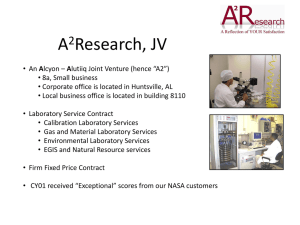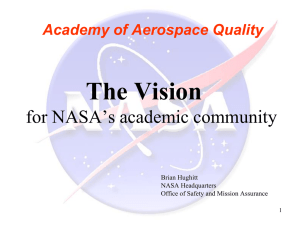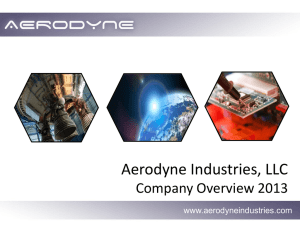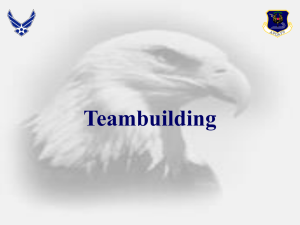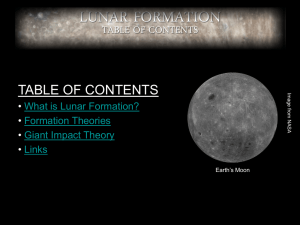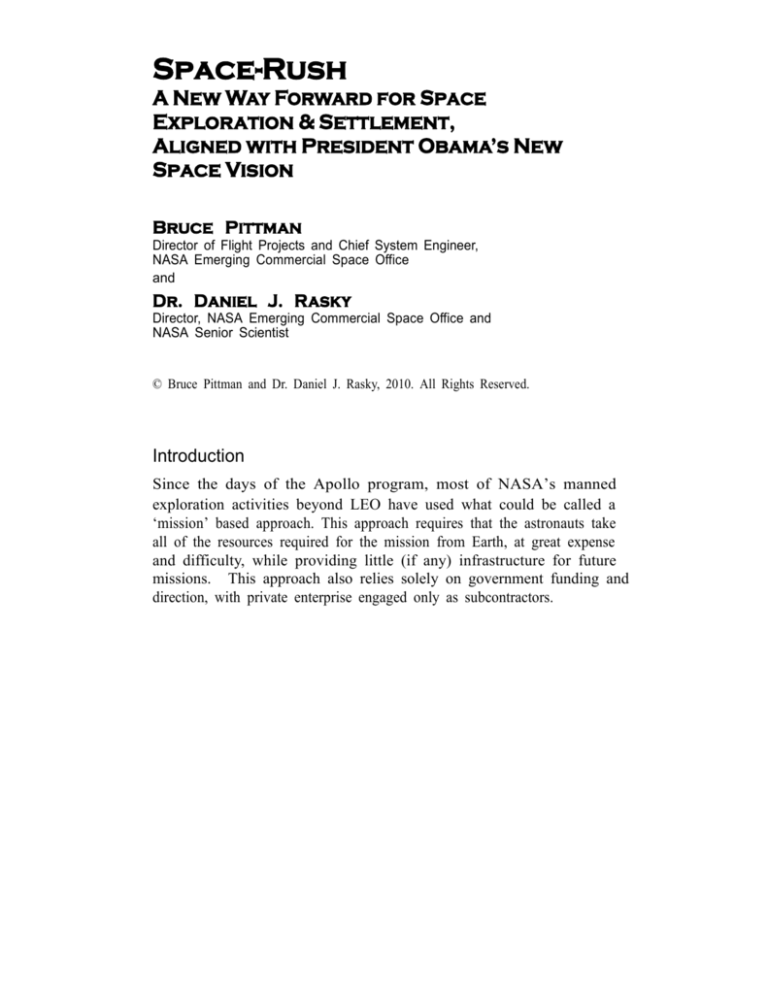
Space-Rush
A New Way Forward for Space
Exploration & Settlement,
Aligned with President Obama’s New
Space Vision
Bruce Pittman
Director of Flight Projects and Chief System Engineer,
NASA Emerging Commercial Space Office
and
Dr. Daniel J. Rasky
Director, NASA Emerging Commercial Space Office and
NASA Senior Scientist
© Bruce Pittman and Dr. Daniel J. Rasky, 2010. All Rights Reserved.
Introduction
Since the days of the Apollo program, most of NASA’s manned
exploration activities beyond LEO have used what could be called a
‘mission’ based approach. This approach requires that the astronauts take
all of the resources required for the mission from Earth, at great expense
and difficulty, while providing little (if any) infrastructure for future
missions. This approach also relies solely on government funding and
direction, with private enterprise engaged only as subcontractors.
154
Space Commerce
In February 2010, President Obama made radical changes to this
historical approach to manned space exploration, including canceling the
Constellation program’s Ares 1 and 5 rockets, the Orion capsule, and the
Altair Lander.
Some of the highlights of the President’s report include:
Extending the life of the ISS until at least 2020.
Relying on private, commercial space companies for crew access
to low-Earth orbit.
A new focus on technology development for exploration and
commercial space, and
Adoption of a ‘flexible path’ architecture for human spaceflight,
with multiple destinations including near Earth asteroids, Lagrange
Points, and eventually the moons of Mars and Mars itself.
There has been considerable controversy concerning this significant
change in direction and approach. Many have suggested that this means
that the US is giving up on manned spaceflight and returning to the Moon,
but we strongly disagree. The Augustine Committee report clearly
indicates that the NASA Constellation program was “on an unsustainable
trajectory” and would not succeed in returning astronauts to the surface of
the Moon until late in the next decade, perhaps by 2028, if then.
The new approach put forward by the President is much more than
just technology development. It is a strategy for embracing the challenge
of sustainable exploration and settlement, ones that goes beyond ‘flags and
footprints.’ It’s the difference between the Lewis & Clark expedition and
building the transcontinental railroad.
As we have seen from other periods of human expansion, including
the settling of the American West, the door to expansion and development
opens when the government establishes a minimum level of infrastructure,
which in the case of the West was railroads and forts, after which
entrepreneurs and settlers quickly followed. This then enabled a significant
reduction in the resources required by the hardy pioneers who followed,
and reduced the difficulties they faced.
When deliberate actions are undertaken to engage private enterprise
(e.g., the Pacific Railway Act and the Homestead Act of 1862),
entrepreneurs then flock in and find ways of making productive use of the
new resources that the frontier offers. These entrepreneurs also bring the
benefits of the frontier back to the settled communities, providing proof of
the value of the new terrain, and creating additional excitement. Taken
together, establishment of infrastructure and engaging private enterprise set
the stage for very effective and rapid expansion and development. For
example during the California gold rush between 1848 and 1850, the
population of San Francisco grew from 1,000 to 35,000 and the cost of a
housing lot skyrocketed from $16 to $45,000.
The Inside Story
155
This route to rapid expansion and development is as true today as
ever, as we see with the recent opening of an important technological
frontier, the Internet. It was the government, specifically the Department
of Defense’s Advanced Research Projects Agency (ARPA) that put in
place the first high-speed data lines between powerful computers in the US
to support government and university researchers in the late 1960s and
1970s. Had this high-speed data transfer capability remained the sole
province of the government, few of us outside of select government and
university scientists would ever have known of its existence, or its utility.
But the door to this high-speed network was opened to resourceful
entrepreneurs in the 1980s, and the Internet was born.
Few could have
anticipated the enormous economic and public benefit that accompanied
the advent of e-commerce and search engine technologies.
Today, the
internet advertising industry alone adds $300B to the US economy,
amounting to 2.1% of US GDP, and this from an industry that did not exist
15 years ago. As with many others, we believe that the economic benefits
to be had from the commercial development of space could be significantly
larger.
Figure 1
NASA illustration showing commerce and habitation on the moon.
A New Way Forward for Exploration
In laying out a path for space exploration for this new millennium, it is
essential to learn from the past and use an effective strategy to enable rapid
156
Space Commerce
expansion and economic development. Such a strategy has critical tasks
for both the government and private enterprise.
The government must enable the demonstration of critical
capabilities, the gathering of critical knowledge, and the development of
key infrastructure. Once these initial activities and developments are
accomplished, the government must not only allow but actively encourage
private sector engagement and investment to enable timely, cost effective,
and productive uses of the new space frontier that show a direct benefit to
the people here on Earth.
This may include new services such as space tourism and
entertainment, new knowledge such as fundamental new understandings of
biology and materials, new products including new medicines, vaccines,
and materials, and new resources including space based power. This will
enable the general public to understand and appreciate the economic and
social value of space, which in turn help to maintain NASA’s relevance.
We call this infrastructure based, private enterprise engaged strategy for
space exploration ‘Space-Rush.’
Five categories of infrastructure can be identified that would greatly
reduce the resources required for space commercialization, and hence the
difficulties that space entrepreneurs will encounter:
1. Optimized Transportation
2. Power and Communications
3. Fuel and Water
4. In-situ Resource Utilization
5. Crew Accommodations
Each of these categories is examined below, including a strategy for
establishing it, and options for engaging private enterprise for the initial
stages, optimization, and broad utilization.
With the capabilities from these infrastructure elements in place and
private enterprise effectively engaged, the potential for important new
products and benefits for Earth would be greatly increased.
Optimized Transportation
NASA has tried repeatedly to develop a ‘next generation’ replacement for
the Space Shuttle over the last two decades, and the story reads like a litany
of missed opportunities.
The National Aerospace Plane (X-30),
VentureStar (X-33), X-34, National Launch System, the Space Launch
Initiative, and most recently Constellation and the Ares 1 and 5 all started
and failed. Billions of dollars have been spent, and millions of man-hours
expended, with very little to show for it. Tragically, few of these vehicles
got even an inch off the ground.
The Inside Story
157
Albert Einstein noted that a sure sign of insanity was when people
keep doing the same things over and over but expect to get a different
result, so we must ask what we can learn from these experiences that will
help us get it right this time? It’s time for us to take this to heart and try
some new approaches in space transportation development, with the goal to
develop an affordable and reliable orbital space transportation system, one
that actually gets to space.
We need to think beyond getting to Low Earth Orbit (LEO), and open
space for public access and commercial development, including access to
the Moon and beyond.
This means considering four different
transportation requirements:
Earth to Orbit (ETO) and return
Orbit to Orbit (OTO), including LEO to Geo-synchronous (GEO),
Earth orbit to lunar and Mars orbit, and finally
Orbit to Extraterrestrial Surfaces (OTES), including the lunar
surface, asteroids, Phobos and Demos, and eventually Mars.
While NASA has been focused almost exclusively on rocketry and
ETO transportation, in addition to rockets there are many intriguing
propulsion options that have not been explored to any significant degree,
including laser propulsion, in which ground or space based lasers are used
to propel a vehicle to orbit, and spinning tethers that could be used to
rendezvous with reusable suborbital rockets. Both of these concepts could
reduce the size, complexity, and cost of launch vehicles.
One of the key goals for optimized space transportation is to develop
fully reusable vehicles that will significantly reduce the cost of space
travel.
Technical performance is not the key to reusable vehicles. The Space
Shuttle is an example of a vehicle that, while refurbishable, is expensive to
operate and maintain. Even with the significant reductions in maintenance
staff between 1995 and 1999, the Shuttle still requires 1800 workers to
keep it operational.
In the design phase for next generation vehicles, emphasis must be
placed on efficient maintainability and operability so that space systems
operate more like commercial airlines, and less like experimental aircraft.
Several suborbital vehicles are now under construction with the goal
to travel to 100 km or more on a routine basis; some are even planning
multiple flights per day with a ground crew of fewer than 10.
These
companies include XCOR Aerospace, Armadillo Aerospace, Masten Space
Systems, Blue Origin, and Virgin Galactic.
Fuel depots are another option that has recently received a good deal
of attention because of the Augustine Committee review of US Human
Space Flight Program. The concept is straightforward: a fuel depot is a
filling station in space, so instead of taking all the fuel you need for your
158
Space Commerce
space mission, you take only enough to get to the depot, where you refuel
just as you refuel your car on road trips. This allows the fuel for the depot
to be launched on less expensive, reusable launchers, and as secondary
payloads on missions that have excess payload margin.
Fuel depot technology has advanced significantly, and we now have
the technology to store liquid oxygen and even liquid hydrogen for
extended periods of time in space with very low boil-off, a key requirement
for storing fuels on orbit for long duration.
Using a fuel depot allows the launch vehicles needed for space
missions to be significantly smaller, potentially eliminating or at least
reducing the need for a heavy lift vehicle.
There is also an interesting synergy between the development of fuel
depots and reusable launch vehicles (RLVs). The key to keeping costs
down on reusable launch vehicles is frequency of flights. If fuel depots are
resupplied by commercial RLVs then this will help provide the demand
needed to close their business case.
(Editor’s note: A somewhat less optimistic view of the fuel depot concept is
presented in Chapter 13, Prospects for In-Space Re-Fueling.)
OTO transfer is conceptually much simpler than ETO travel. OTO
can be subdivided into a couple of categories. The first of these is LEO to
GEO transport. The idea of a reusable space tug to provide LEO to GEO
transportation has been studied for decades. The Orbital Transfer Vehicle
(OTV) and its several derivatives were studied by NASA, Lockheed, and
Boeing in the 1970s and 80s, but were never developed for budget and
programmatic rather than technical reasons. OTVs could also make use of
fuel depots, and they could also utilize aerobraking to slow OTVs down by
using the Earth’s atmosphere to slow the OTV down when it returns from
GEO to LEO.
The original NASA concept was to house OTVs at a space station.
Payloads would be launched from Earth on an ETO vehicle that would
dock at the Station. There, the payload would be removed and attached to
the OTV. The OTV would then take the payload to GEO orbit, where it
would be released. The OTV would use its aerobrake to return to the
station.
A velocity change of about 4 km/sec is required to get from LEO to
GEO, as well as a required plane change to the angle of orbit.
Coincidently, this is the same velocity change that is needed to get to Low
Lunar Orbit (LLO) from LEO (4.04 km/sec) (see figure 2). Therefore the
same type of OTV that is used for Earth orbit and GEO could also be used
to transfer payloads to and from lunar orbit.
In additional to chemical propulsion, advanced propulsion
technologies offer the potential of improved performance that could open
up the solar system for commerce and settlement.
Ion propulsion
The Inside Story
159
technology has already been demonstrated in space with the Deep Space 1
and Dawn missions to the Moon, Mars and the asteroid belt. Although the
thrust is low, often a fraction of a pound, the propulsion efficiency (Isp) is
very high, and as it runs continuously, after weeks or months very high
velocities can be achieved. This is fine for cargo, but not useful for
transporting people.
There is also a particular problem when leaving LEO due to the
extended time the vehicle spends in the Van Allen radiation belt.
Figure 2
General categories of orbital inclination planes.
What is needed is another option that could be used to propel the
OTV from LEO to GEO or LLO.
To open up the solar system, what is needed is a high thrust system
that also has high Isp, and there are a few possibilities that could be quite
attractive. Former astronaut Dr. Franklin Chang Diaz and his company Ad
Astra have developed the VASIMR (Variable Specific Impulse
Magnetoplasma Rocket) concept, which will produce both high thrust and
high specific impulse. A VASIMR prototype has been tested in the
laboratory up to 200-kilowatts, and worked as expected.
Ad Astra has signed a Space Act Agreement with NASA to fly the
VASIMR engine on the International Space Station. A 200MW VASIMR
engine could propel a manned mission to Mars in less than 40 days,
compared to the 270 days it would take using chemical propulsion.
We
will discuss how to achieve these power levels in the next section.
The last transportation segment to consider is from OTES and back.
A good example is LLO to the lunar surface. Since there is no air on the
moon, a hypergolic propulsion system similar to what was used on
160
Space Commerce
Surveyor and Apollo could be used, and there are interesting options to
consider. One possibility is to harvest rocket fuel from the lunar soil in a
process called in-situ resource utilization (ISRU).
Figure 3
Human Mission to Mars with a Nuclear Powered VASIMR engine.
Illustration courtesy of Ad Astra.
As the Moon is ~45% oxygen by mass, rather that transporting
oxygen from Earth to the lunar surface at great expense, extracting the
oxygen required for the return trip from the lunar soil is an attractive
option. Twenty-seven different possible processes have been identified for
performing such an extraction.
A great benefit of this approach is that by-products of oxygen
extraction include iron, silicon and titanium, all of which are of course
valuable materials.
Another, more technologically advanced option would be a Lunar
Elevator that would go from the Earth/Moon L1 point to the Lunar surface,
a distance of 56,000 km. While building a space elevator on Earth is
beyond the current capabilities of materials technology, this is not the case
on the Moon with its lower gravity and lack of atmosphere. A cable would
be lowered from L1 to the Lunar surface and a climber vehicle attached to
the cable. Using beamed power (laser or microwave), the climber would
ascend the cable, completing the journey in a matter of a few days at very
low cost. The process would then reverse, and cargo and people would
descend from the L1 terminus to the Lunar surface.
The Inside Story
161
Technologies including mass drivers and rotating tethers will be the
subjects of further R&D for their possible application to the Moon, where
they may be particularly well suited.
A mass driver is a long electro-magnetic accelerator with a series of
coils through which a conducting payload canister is accelerated. It is kind
of like a linear motor. A rotating tether is like a two rocks rotating on a
common string. If the string is cut at the right time they will go flying off
in opposite directions. In orbit, one would go to a higher orbit and one
could be re-entered into the atmosphere.
Devices such as these may ultimately make the mining of such high
value materials such as Helium-3 (which we will discuss in the next
section) economically viable.
Power and Communications
Power and communications are the next essential infrastructure elements.
One concept that has particular potential for both government initiation and
private enterprise is in-space power beaming.
Using current US
government capabilities in high-power lasers, and US industry’s large
satellite design capabilities, several hundred-kilowatt space power stations
could be designed and constructed incorporating new high efficiency
photovoltaic solar cells and other relevant technologies. These space
power satellites could then beam power to locations of space activities,
such as the lunar surface or Lagrange points. These space power stations
could also serve as communications hubs, transferring broadband data to
and from points of interest.
A government directed demonstration program could accomplish the
necessary initial infrastructure for these space power and communication
stations. One very useful activity would be to construct a demonstration
space power and communication station to support NASA’s lunar surface
missions. With successful demonstration of the necessary technologies and
systems, construction and deployment of operational power and
communication power stations could be handed off to industry.
Borrowing from the NASA Commercial Re-Supply (CRS) program
for the ISS, an agreement could be offered through which the government
agrees to purchase minimum levels of power and data communication from
the stations.
To go beyond the moon will require large amounts of power for such
systems as the VASMIR. Power levels from 100MW to 10GW would be
required to truly open up the solar system for exploration, commerce and
settlement.
Power systems for space propulsion differ in two key ways from
terrestrial, stationary counterparts. The first is that output power is not the
only consideration, as energy density, measured as kilowatts per kilogram,
162
Space Commerce
is also a vital factor. The other key difference is that getting rid of waste
heat is much more difficult in space than on Earth, so energy conversion
efficiency becomes important. In space both conduction and convention
are not viable for getting rid of waste heat, and this leaves only radiation,
but the radiators required to dispel waste heat can add a very severe mass
penalty to the design of a vehicle, and also severely handicap its
performance.
In the past, the primary mechanisms for providing power to space
systems has been solar energy and nuclear fission. Solar energy is typically
collected by solar cells that convert incoming photons into electricity. This
works well for power levels up to 10-100 kilowatts, but for higher power
levels the arrays become very large. But as one travels outward from
Earth’s orbit toward Mars, the energy flux (energy/unit area) from the sun
decreases, requiring an increase in the size of the solar array required to
produce the same amount of power.
Nuclear fission is the other approach that has been used.
Radioisotope Thermoelectric Generators (RTGs) have been used on all of
the unmanned outer planet probes, including Pioneer, Voyager, Galileo,
and Ulysses. These devices generate heat from the nuclear decay from the
fissionable material, typically plutonium, and then convert this heat to
electricity using thermocouples. The energy conversion efficiency of these
devices is very low (3-7%), but they are very simple and reliable. These
systems work well for low power levels less than one KW, but do not scale
well.
However, there are other technologies under development that can
help meet these challenges. Two options discussed here are Nuclear
(fission) Thermal Rocket (NTR), and A-neutronic Fusion Rockets (AFR).
The concept for a NTR is to use the fission reactions in the reactor core as a
heat source, run fluid through the core to heat it up and then expand this hot
gas/plasma out the back as fast as you can. From the late 1950s through
the early 1970s the US spent $1.4B on solid-core nuclear rocket R&D, and
more than 20 NTR reactors were designed, built, and tested at the Nevada
Nuclear Test Site at Jackass Flats Nevada.
These engines achieved exhaust temperatures of 2,350-2,550 K using
graphite fuel and an Isp of 825-850 seconds with burn durations from 62
minutes to over 4 hours, and an engine thrust to weight of ~3. The
technology of these engines was relatively mature in 1970s, and some work
has continued by companies such as Aerojet as recently as 2002, so it may
not be a significantly difficult feat to develop such an engine for space
applications.
The public relations difficulty, however, concerning
launching nuclear material is another matter altogether.
The second option is the AFR, which differs from the conventional
approach to achieving fusion that the US has pursued for the last half
century. This conventional approach attempts to burn a mixture of tritium
The Inside Story
163
(a radioactive gas) and Deuterium (DT), both of which are isotopes of
hydrogen. This fuel combination is the easiest one in which to induce
fusion (13.6 keV required), but even if DT fusion is achieved, it presents
several drawbacks, including the fact that 80% of the energy released in
this reaction comes out as energetic (14 MeV) neutrons and only 20%
comes out as charged particles. These high-energy neutrons cause many
problems, including inducing radioactivation (the neutron flex changes the
atomic structure of the of the surrounded structure) that causes the material
to become radioactive as well as degrading material strength. The only
way these neutrons can be turned into useful energy is to thermalize them
(using a large blanket of liquid lithium for instance) and then running this
hold fluid through a steam cycle to produce electricity. Due to materials
limitations, the Carnot efficiency of such processes is very low (<20%),
and it produces a very large waste heat problem for any space application.
Fortunately, there has been significant recent progress in a different
approach, a-neutronic fusion. A-neutronic fusion differs from conventional
fusion reactions in that neither of the fuel elements is radioactive, and the
resulting fusion products are charged particles. Two a-neutonic reactions
are of particular interest for space applications, DT and He3 (D-He3), and
Protium (ionized hydrogen) and Boron (P-B11). D-He3 is easier to burn –
58 keV compared to 123 keV for P-B11. Since this is a more difficult
technical challenge, new approaches need to be tried to reach these high
energies. However, the US Department of Energy (DOE) has repeatedly
refused to provide significant support to these advanced concepts despite
numerous calls by Congress to do so. Some efforts are nevertheless under
way, but most are under funded, which of course limits their progress.
Another interesting a-neutronic fusion concept is inertial
electrodynamic fusion (IEF). P. T. Farnsworth and Robert Hirsch
developed the basic concept for IEF in the 1960s as a spherical accelerator.
Electrostatic potentials are used to accelerate the particles to velocities
where their momentum can overcome the coulomb barrier and fusion can
occur. Materials limitations prevented the Farnsworth/Hirsch device from
producing net power, until in the 1980s when Dr. Robert Bussard modified
the Farnsworth/Hirsch device and replaced their electron grid with a
magnetically-insulated ‘magrid.’ Over the next two decades with funding
from the Navy (although none from DOE) Bussard’s company EMC2 was
able to demonstrate many of the fusion requirements for a practical fusion
device, including producing 109 fusion reactions/sec at very low voltage
(10 kV). Unfortunately, Dr. Bussard passed away in 2007, but his work is
being carried on by Dr. Richard Nebel.
In 2009 the Navy awarded EMC2 a $12M contract that, if all the
options were exercised, would demonstrate PB11 fusion in 2012. Dr.
Nebel predicts that the next power producing system could be
demonstrated by 2020, a system that could be capable of producing
164
Space Commerce
hundreds of megawatts to gigawatts of electrical power, with no
radioactivity, and at conversion efficiencies as high as 95%.
Shortly before his death Dr. Bussard made a presentation at the
International Space Development Conference on space applications using
IEF technology, and he predicted that IEF could power a colony on Mars
capable of housing 1200 people with 50 tons of supplies each, for under
$20B.
Several other a-neutronic fusion concepts have received public or
private funding, including efforts by Tri Alpha and FRC machine,
Lawrenceville Plasma Physics and their Dense Plasma Focus, Magnetized
Target Fusion at Los Alamos National Lab, as well as a Sandia Labs and
Prometheus II Ltd. PLASMAK device. Each of these devices has unique
advantages and challenges, but experimental work has been done and the
results have been encouraging enough to continue development. Most if
not all of these concepts could provide the energy levels and propulsion
performance that could open up the solar system for commerce and
settlement.
Fuel and Water
As previously noted, space fuel depots could constitute an important new
space infrastructure. A primary function will be to store liquid oxygen and
hydrogen, as well as other expendables, including water. Ample supplies
of hydrogen and oxygen enable you to produce water easily in standard
fuel cells that also then provide electrical power. A space depot could
therefore be an important source of fuel, water and even food grown in
space based greenhouses, which would support a wide range of activities of
interest to both government and commercial firms. With access to the
lunar surface or suitable asteroids, in-situ resource utilization (ISRU)
techniques could employed to provide additional sources for fuel, water,
and even building materials.
Government demonstrations of space depots should be the first step,
and when the techniques and technologies are proven the government could
then turn over construction and operational of space fuel depots to industry.
As with power and communication contracts, minimum government
purchase agreements for fuel, water, and even food, could provide a
guaranteed market to ensure and stimulate commercial adoption of these
facilities.
Recent discoveries by NASA’s Moon Minerology Mapper (MMM)
on board India’s Chandrayaan-1 Lunar Orbit, and by the US Lunar
Reconnaissance Orbiter (LRO) and Lunar Crater Observation and Sensing
Satellite (LCROSS) probe, reveal data that suggest that there is at least 600
million tons of water contained in ice sheets 1 to 3 meters thick on the
moon’s north pole. This invaluable resource could be used to support a
The Inside Story
165
variety of purposes, including providing oxygen to breathe, water to drink
and grow crops, and hydrogen and oxygen for propulsion and many other
industrial purposes, including re-supply of orbiting fuel depots.
In-Situ Resource Utilization (ISRU)
Living off the land has historically been the key to opening up new
frontiers. When American settlers moved west of the Mississippi they
came upon the Great Plains with not a tree is sight. To create shelter they
could have hauled wood to build traditional houses, but that would have
been prohibitively expensive. Instead they used local materials such as sod
and adobe to build a new kind of structure that could keep cool in the
summer and warm in the winter. Similarly, space settlers will need to learn
to live off the resources that they find wherever they go.
While the moon is mostly oxygen, it also contains other valuable
materials including iron, silicon, aluminum, calcium, magnesium, sodium,
and titanium. The data from LCROSS from the Oct. 9, 2009 impact shows
definitively that there is water ice in the permanently sheltered charts on
the poles of the moon as well as other economically valuable materials.
The abundance of solar radiation on the moon could be readily
applied to breaking down the compounds into a useful form. For example,
as noted above, 27 different processes have been identified for extracting
oxygen from the lunar soil, and a great side benefit of many of them is that
the by products are iron, silicon, and titanium, all of which are very
valuable in their own right.
The asteroids are also sources of mineral wealth. While most of the
known asteroids are located far from Earth in orbit between Mars and
Jupiter, there is a class of asteroids called Apollo objects which have orbits
that come very close to and in some cases cross the orbit of the Earth.
These objects are a potential source of raw materials, but they also pose a
threat because a collision with even a small object (100 m) could be
catastrophic, suggesting that it is important to learn more about this objects
for profit and also for protection.
Hence, Congress has tasked NASA with “detecting, tracking,
cataloging and characterizing near-Earth asteroids and comets in order to
provide warning and mitigation of the potential hazard of such near-Earth
objects (NEOs) to the Earth.” In response, NASA established a program to
identify and track NEO’s greater than 140 meters in diameter.
As of August 2009, 6,244 such objects had been cataloged.
Asteroids make up the majority of these objects, and there are two major
types: 1) metallic and 2) carbonaceous chondrites. A typical metallic
asteroid is composed of iron and nickel, both valuable elements. A single 1
km wide metallic asteroid could provide the earth with enough iron and
nickel to meet the current world demand for 2 - 3 years. Carbonaceous
166
Space Commerce
chondrites, on the other hand are made of silicates, oxides and sulfides, but
more importantly a significant portion of them contain water (from 3-22%)
and other volatiles.
From an energy point of view, many of these NEOs require even less
delta V to reach them than is required to land on the moon, which would
conceivably make it possible to mine these objects for valuable materials
elements, and then return them to cis-lunar space for use and economic
benefit.
Crew Accommodations
Expandable space habitation modules can be purchased today from
commercial providers such as Bigelow Aerospace. The Bigelow
expandable space habitat is a success story that should be noted and copied.
The design of this deployable habitat was adapted from a NASA advanced
technology program called Transit Habitat, run by Johnson Space Center in
the 1990s, with the intention to design an interplanetary vehicle to transfer
humans to Mars. The Transhab concept that emerged from this project was
intended as a replacement for the already existing International Space
Station crew Habitation Module. But while the ISS habitation module is a
rigid structure, inflatable modules can be launched in a compact form.
When fully inflated, Transhab would expand to 8.2 meters in diameter
(compared to the 4.4 meter diameter of the Columbus ISS Module).
Controversy arose during Transhab development due to delays and
increased costs of the ISS program, and the National Space Society issued a
policy statement recommending that NASA cease development of
Transhab. Finally in 2000, House Resolution 1654 was signed into law
banning NASA from conducting further research and development of
Transhab, but an option to lease an inflatable habitat module from private
industry was included in the bill.
Since that time, Bigelow Aerospace has purchased the rights to the
patents developed by NASA, and is pursuing a similar scheme for a private
space station design. The company has launched the Genesis I and Genesis
II pathfinder spacecraft, with plans for additional experimental craft
culminating in their BA 330 production model. Bigelow plans to launch
the first series of expandable modules to orbit in 2014, and to welcome the
first inhabitants in 2015. By 2020 he could accommodate as many as 24
people in orbit at one time.
The government may be interested in purchasing expandable habitats
for space, and even for lunar sorties and outposts it would seem to be a
very effective approach to crew accommodation. Developing and using
ISRU to help provide oxygen, fuel, building materials and even food would
be a natural extension of this concept. Continued government supported
for research and development on advanced technologies and concepts, for
The Inside Story
167
crew accommodations and life support systems would also be a smart
investment. As history has shown many times, government developed
concepts, like Transhab, that are proven and then transferred to industry,
can lead to rapid and significant benefits for the government, industry, and
the general public.
Summary
History tells us that infrastructure-based exploration led by the government,
with active engagement of industry, provides the best opportunity for
economic expansion in the space frontier. As the expansion of the railroads
and Internet shows, this strategy offers the best means of providing the
necessary foundation for development while engaging the entrepreneurial
spirit of the private sector for economic and social benefit.
The ‘Space-Rush’ strategy described here recommends focusing on
four critical infrastructure elements:
1. Optimized Transportation,
2. Power,
3. Fuel, Water and Materials, and
4. Crew Accommodations.
Using government-funded demonstrations, followed by guaranteed
purchase agreements to assure minimum demand while engaging private
entities provides a proven path for success.
Important activities that could be pursued immediately include space
fuel depot development, in-situ resource utilization experiments, space
power beaming demonstrations, and expandable crew accommodation
purchases. Re-establishment of long-range government funded technology
programs should also be pursued to assure that new and improved
technologies are continually under development.
With ‘Space-Rush’ we will finally begin to open space to rapid and
beneficial development for the government, industry, and the general
public.
•••
168
Space Commerce
Bruce Pittman
Bruce Pittman is the Director of Flight Projects and Chief
System Engineer at the NASA Emerging Commercial
Space Office at the Ames Research Center, where he
supports programs ranging from suborbital human-tended
research, orbital applications and research, low cost,
responsive access to space, and lunar commercialization.
He has been involved in high technology product
development, project management and system engineering
for over 30 years.
He started his career at NASA Ames for 11 years on projects including
Pioneer Venus, the Infrared Astronomy Satellite (IRAS), the Cryogenic
Grating Spectrometer on the Kuiper Airborne Observatory, the Space Station
Freedom Technology Advocacy Group, and several advanced studies
programs. He has also worked with NASA as a contractor on projects
including the NASA Emerging Commercial Space Office (2005-present),
Commercial Orbital Transportation Services (2006-2007), International Space
Station Commercialization (2005-2006), High Speed Civil Transport (19971998), Program and Project Management Initiative (1988-1993), the Space
Exploration Initiative (1989-1991) and Space Shuttle Processing (1987-1988).
Mr. Pittman has also been a founder and member of the startup team of
early stage growth companies including SpaceHab, Kistler Aerospace, New
Focus, Product Factory, Prometheus II Ltd., and Industrial Sound and Motion.
Mr. Pittman has a BS in Mechanical Engineering from U. C. Davis and a
MS in Engineering Management from Santa Clara University. Mr. Pittman is
an Associate Fellow of the American Institute of Aeronautics and Astronautics
(AIAA) a member of the AIAA Commercial Space Group and founder and
first chairman of the System Engineering Technical Committee. He is also a
member of the organizing committee for the Space Investment Summit series,
a member of the Aerospace Technology Working Group (ATWG), and
President of the Silicon Valley Space Club. He has authored or co-authored
more than 3 dozen papers on a technical, management and business topics in
aerospace and high technology. In addition to his technical work Mr. Pittman
is also a member of the adjunct faculty in the Graduate Engineering School at
Santa Clara University.
For his technical work Mr. Pittman has been awarded 2 NASA Special
Achievement Awards, four NASA Group Achievement Awards, and the AIAA
Distinguished Leadership Award.
The Inside Story
169
Dr. Daniel J. Rasky
Dr. Daniel J. Rasky is the Director for the Emerging
Commercial Space Office at NASA Ames, and also a
Senior Scientist with NASA. He is a Co-Founder and
Director for the Space Portal whose mission is to “Be a
friendly front door for emerging and non-traditional space
companies.”
He recently completed a one-year
Interagency Personnel Assignment (IPA) with the Space
Grant Education and Enterprise Institute (SGEEI), where
he served as a Senior Research Fellow supporting a
number of emerging space companies and other organizations. This included
provided expert consulting to SpaceX on the design and development of the
heatshield for their Dragon capsule. SpaceX has chosen to use the PICA
heatshield material, invented by Dr. Rasky and associates at NASA Ames, for
Dragon.
Dr. Rasky is an internationally recognized expert on advanced entry
systems and thermal protection materials, with 25 years of experience in
advanced entry systems and materials for NASA (20 years) and the US Air
Force (5 years). Dr. Rasky has made significant contributions to flight
hardware on seven NASA missions, including co-inventing the PICA
heatshield material that enabled the NASA Stardust comet sample return
mission, and is the primary heatshield for the Mars Science Laboratory (MSL)
lander mission.
Dr. Rasky is the recipient of the NASA Inventor of the Year Award (the
first ever for NASA Ames), the Senior Professional Meritorious Presidential
Rank Award, the NASA Exceptional Achievement Award, the NASA
Exceptional Service Medal, twelve NASA Group Awards, and eight Space Act
Awards. He has 6 patents, 64 publications, is an Associate Fellow of the
AIAA and Senior Member of the ASME.
170
Space Commerce
References
1.
2.
3.
4.
5.
6.
D. Schrunk, B. Sharpe, B. Cooper, M. Thangavelu, The Moon: Resources,
Future Development and Settlement, Springer Publishing, NY, 2008
G. Sanders, M. Duke, NASA In-Situ Resource Utilization (ISRU)
Roadmap, Final Report, May 2005
NASA 2008 Authorization, HR 6063.
Pioneering The Space Frontier, The Report of the National Commission
on Space, 1986.
D. Wingo, MOONRUSH: Improving Life on Earth with the Moon’s
Resources, Apogee Books, Ontario, Canada, 2004.
S. Ambrose, Nothing Like It In The World: The Men Who Built The
Trans-continental Railroad 1863-1869, Simon and Schuster, NY, 2000.




